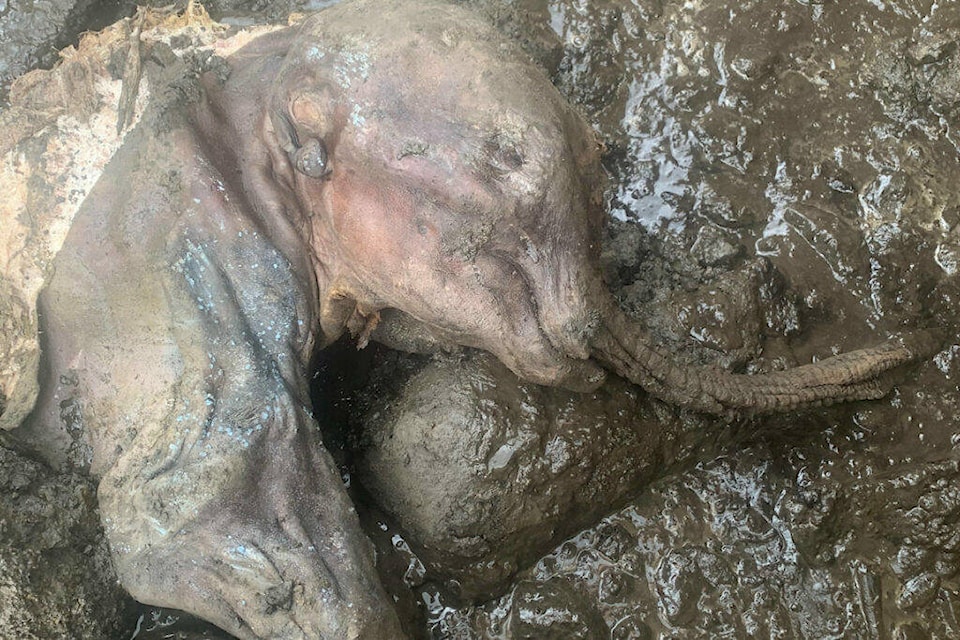Your job may include moments of magic. But probably not as magic as a placer miner discovering a baby woolly mammoth frozen in ice age permafrost for 35,000 years. Or a paleontologist seeing a once-in-a-career photo pop into their iMessages.
The find on Eureka Creek in the Klondike gold fields is a major scientific and cultural event for Yukon placer miners, the Tr’ondëk Hwëch’in First Nation, Yukon paleontologists and Yukoners in general.
Kudos to the miners who spotted the find and reported it immediately. And to the Yukon paleontologists who have spent years building deep relationships with the industry; apparently one Yukon paleontologist had a photo of the mammoth on his phone less than an hour after discovery. And to the Tr’ondëk Hwëch’in First Nation staff involved, and the elders who named it Nun cho ga.
We can guess that such discoveries in other parts of the circumpolar north often go unreported, to the shared loss of humanity.
Yukoners are not the only ones fascinated by the distant past. The Jurassic Park movie franchise brought in over $5 billion over the years despite — let’s admit it — dinosaurs being less interesting than Yukon creatures like woolly mammoths and sabre-tooth tigers.
For now the focus is rightly on preserving, studying and interpreting the find.
But then the question will come up about how to share the story of Nun cho ga with current and future generations.
Our Arctic Winter Games friends in Yamal made a similar find in 2007. An Indigenous Nenets hunter and his sons found Lyuba, a well-preserved baby mammoth about 42,000 years old. According to the Shemanovsky Museum in Salekhard, capital of the Yamalo-Nenets Autonomous Okrug, Lyuba is now the museum’s most popular exhibit. Lyuba has racked up more than 100,000 air miles visiting exhibitions around the world, including the one at the Royal BC Museum in Victoria where I saw her.
It may seem crass to talk about shipping priceless artifacts around the world so economists and the rest of the hoi polloi can gawk at them.
But think of how many young people such an exhibit can inspire. Maybe they’ll become paleontologists themselves when they grow up. Or maybe they and their parents will learn a few things that open their minds a bit: that permafrost exists; that it is melting; that First Nations people have a history in the North going back tens of thousands of years (some researchers think another Russian mammoth named Yuka may have been butchered by ancient humans).
Ötzi the Iceman is another example. Described by the South Tyrol Museum of Archeology as “archaeologic sensation, media star, research topic, museum object,” Ötzi was murdered 5300 years ago high in the Alps. His body was preserved in the ice until his discovery in 1991, complete with tattoos and all his clothing and equipment.
I also dragged the family to Ötzi’s museum. He is treated with respect in a custom-designed cryogenic cell. Visitors spend most of their time looking at carefully made replicas that explain his story and copper-age lifestyle.
Unlike some mammoths who ended up in Moscow, both Lyuba and Ötzi stayed in their home regions. Local people work at their museums and local scientists are closely involved in the scientific work.
Ötzi’s museum is in Bolzano, a town of about 100,000 people in the mountains of northern Italy. The museum is in a restored bank building and employs 43 bolzanini. In addition to opening for visitors, the museum’s scientific staff is involved in studies on everything from Ötzi’s copper ax blade to the economics of prehistoric alpine villages.
It would be marvellous if such a high-quality institution could be built in Dawson around the legacy of Nun cho ga, perhaps in partnership between the Tr’ondëk Hwëch’in First Nation, Yukon paleontologists and the placer miners.
The Yukon government has $29-40 million set aside for a new Arts and Heritage Resource Centre in Whitehorse. I’m not sure what they plan to put in that building that is not already in Whitehorse facilities such as the MacBride Museum, Kwanlin Dün Cultural Centre, Transportation Museum, Beringia or the Old Log Church Museum. But perhaps some of this money could go to building a facility worthy of Nun cho ga.
It would be marvelous if we could someday visit Dawson and, after checking in on recent events such as the Klondike Gold Rush, connect with our ice age past. Maybe people from Bolzano and Yamal would visit.
Keith Halliday is a Yukon economist, author of the Aurore of the Yukon youth adventure novels and co-host of the Klondike Gold Rush History podcast. He is a Ma Murray award-winner for best columnist.
